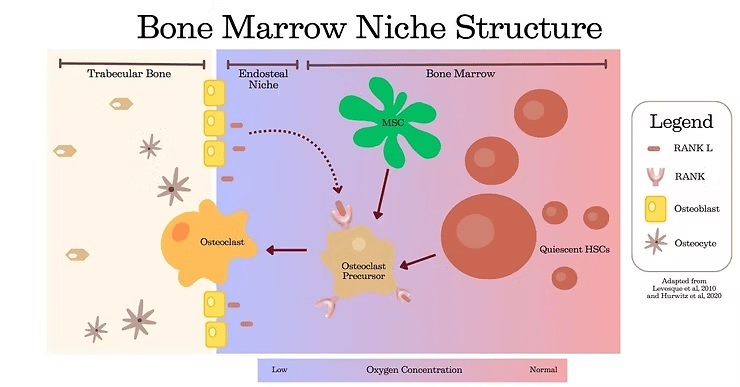What do osteoporosis, periodontitis, and rheumatoid arthritis (RA) have in common? Could their shared mechanisms hold the key to improving bone repair? And did you know that your bones and immune system are in constant communication, affecting your health in ways you might not expect? We’ll explore these fascinating questions in this blog post, the first in our series on osteoimmunology.

Chronic Inflammation: Persistent inflammation drives both periodontitis and RA, and it can contribute indirectly to the bone loss seen in osteoporosis.
Bone Loss: All three conditions involve bone resorption:
Osteoporosis leads to systemic bone density reduction.
Periodontitis causes localized bone loss in the jaw.
RA results in joint erosion and periarticular bone loss.
Immune System Dysregulation: Overactive immune responses, driven by cytokines TNF-α and IL-6, play a key role in RA and periodontitis. These same cytokines contribute to bone loss in osteoporosis.
Shared Risk Factors: Smoking, aging, and genetic predispositions are common risk factors for all three conditions.
Microbial and Molecular Links: In periodontitis, bacteria like Porphyromonas gingivalis can trigger immune responses that are also implicated in RA. These inflammatory pathways can exacerbate bone loss, linking them to osteoporosis.
Osteoimmunology Interplay: The RANK/RANKL/OPG axis, which regulates bone remodeling, is a shared pathway affected in all three conditions.
| Molecule | Skeletal System Role | Immune System Role |
|---|---|---|
| RANK | Expressed on osteoclast precursors Promotes osteoclast differentiation and activation | Expressed on dendritic cells, aiding survival and activation Involved in lymph node, thymic medulla, and small intestine Peyer’s patches development |
| RANKL | Produced by osteoblasts and osteocytes to regulate bone remodeling Stimulates osteoclastogenesis when bound to RANK | Expressed by T cells, influencing dendritic cell function Modulates immune response |
| TNF-α | Promotes osteoclastogenesis, leading to increased bone resorption | Role in lymph node development Recruits and activates macrophages and neutrophils |
The endosteal niche, located at the inner surface of bones and lining the medullary cavity, is a bustling hub of crosstalk between bone and immune cells. This niche includes osteoblasts, osteoclasts, MSC, reticular cells, and extracellular matrix components. The endosteum is essential in bone growth, remodeling, and repair, while contributing to the maintenance and self-renewal of HSC, and maturation of lymphocytes and myeloid cells (4, 5). Intermediates of the immune system, including cytokines and interleukins, significantly influence the function of this niche (6).
Osteoblasts secrete key signaling molecules that regulate the HSC niche.
Osteoclasts share a common lineage with myeloid precursor cells, which differentiate into macrophages and dendritic cells; all differentiate from bone marrow HSC.
Osteoclast Precursors circulate in blood like other hematopoietic cells and are upregulated during inflammation.
Cytokines and Chemokines regulate the activity of osteoblasts and osteoclasts, linking immune responses to bone mass and turnover (5,7).
Macrophages, residing near osteoblasts, are essential for bone remodeling and fracture repair (8).
Osteoimmunology is unlocking new insights into the crosstalk between bones and the immune system. By understanding these interactions, researchers aim to develop innovative treatments for conditions like osteoporosis, periodontitis, and RA.
Bergin, S. M., Crutcher, C. L., Keeler, C., Rocos, B., Haglund, M. M., Michael Guo, H., Gottfried, O. N., Richardson, W. J., & Than, K. D. (2023). Osteoimmunology: Interactions With the Immune System in Spinal Fusion. International Journal of Spine Surgery, 17(S3), S9–S17. https://doi.org/10.14444/8556
Tsukasaki, M., & Takayanagi, H. (2019). Osteoimmunology: Evolving concepts in bone–immune interactions in health and disease. Nature Reviews Immunology, 19(10), 626–642. https://doi.org/10.1038/s41577-019-0178-8
OrthoDB v11: annotation of orthologs in the widest sampling of organismal diversity D Kuznetsov, F Tegenfeldt, M Manni, M Seppey, M Berkeley, EV Kriventseva, EM Zdobnov, NAR, Nov 2022, doi:10.1093/nar/gkac996. PMID:36350662
Okamoto, K., & Takayanagi, H. (2019). Osteoimmunology. Cold Spring Harbor Perspectives in Medicine, 9(1), a031245. https://doi.org/10.1101/cshperspect.a031245
Ponzetti, M., & Rucci, N. (2019). Updates on Osteoimmunology: What’s New on the Cross-Talk Between Bone and Immune System. Frontiers in Endocrinology, 10, 236. https://doi.org/10.3389/fendo.2019.00236
Cai, L., Lv, Y., Yan, Q., & Guo, W. (2024). Cytokines: The links between bone and the immune system. Injury, 55(2), 111203. https://doi.org/10.1016/j.injury.2023.111203
Lorenzo, J., Horowitz, M., & Choi, Y. (2008). Osteoimmunology: Interactions of the Bone and Immune System. Endocrine Reviews, 29(4), 403–440. https://doi.org/10.1210/er.2007-0038
Dar HY, Azam Z, Anupam R, Mondal RK, Srivastava RK. Osteoimmunology: The Nexus between bone and immune system. Front Biosci (Landmark Ed). 2018 Jan 1;23(3):464-492. doi: 10.2741/4600. PMID: 28930556.
Guder C, Gravius S, Burger C, Wirtz DC and Schildberg FA (2020) Osteoimmunology: A Current Update of the Interplay Between Bone and the Immune System. Front. Immunol. 11:58. doi: 10.3389/fimmu.2020.00058
Lévesque JP, Helwani FM, Winkler IG. The endosteal ‘osteoblastic’ niche and its role in hematopoietic stem cell homing and mobilization. Leukemia. 2010 Dec;24(12):1979-92. doi: 10.1038/leu.2010.214. Epub 2010 Sep 23. PMID: 20861913.
Hurwitz SN, Jung SK, Kurre P. Hematopoietic stem and progenitor cell signaling in the niche. Leukemia. 2020 Dec;34(12):3136-3148. doi: 10.1038/s41375-020-01062-8. Epub 2020 Oct 19. PMID: 33077865.
© 2025 Molecular Matrix, Inc. All rights reserved.